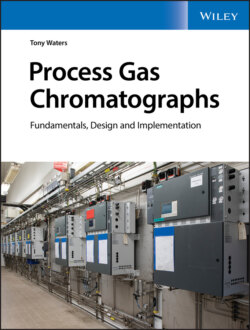Читать книгу Process Gas Chromatographs - Tony Waters - Страница 72
Significance of the air peak
ОглавлениеThe air peak is a valuable indicator of column performance. Since air doesn't dissolve in column liquids to any significant extent, the air peak remains in the gas phase all the way through the column – traveling at full gas velocity. We call it an unretained peak. Its position on the chromatogram indicates the elapsed time for the carrier gas to travel from one end of the column to the other end.
If using a detector that doesn't respond to air, another unretained peak can act as a surrogate. For instance, methane often serves as an adequate “air peak” on a flame ionization detector.
Since we know the column length (L), the air peak retention time (tM) allows us to calculate the average carrier gas velocity (uM) in m/s:
(3.1)
We don't need this information now, but Equation 3.1 is used in more advanced work to optimize the carrier gas flow rate.
The air peak location is good to know when troubleshooting because component molecules can't travel faster than the carrier gas, so no peaks from the current sample injection can elute before the air peak.
But the air peak has a much more significant role because it shows how long the carrier gas took to pass through the column. Recall that component molecules can move along the column only when they are in the carrier gas. So, to get through the column, all component molecules must spend the same time in the carrier gas as the air peak does.
As a way of emphasizing the point, imagine that the column had no liquid inside; where would the peaks be on the chromatogram?
Yes, of course, all the peaks would elute together with the air peak. With no liquid present, no separation can occur. The air peak reveals the time that component molecules spend in the gas phase, and it's the same for every component.
As an aside, realize from this imagined experiment that the time a peak spends in the liquid phase is proportional to the amount of liquid phase present in the column. In packed columns, the liquid film can slowly evaporate into the carrier gas, thereby, over time, reducing the observed peak retention times.
On a more typical chromatogram such as the one in Figure 3.3, the component peaks come out some time after the air peak. This additional retention time, different for each component and plainly visible on the chromatogram, is the time that each component spends in the liquid phase.
An air peak tells us how long the carrier gas takes to get through the column, which is also the time that each component spends in the gas phase. The additional retention time for each peak is the time that peak spends in the liquid phase.
Figure 3.3 Significance of an Air Peak.
Figure 3.3 illustrates the point: the peak retention time (tR) is the sum of two times; the time that the peak spends in the gas phase (tM) plus the time it spends in the liquid phase (t′R):
(3.2)
Notice that the air peak neatly divides the chromatogram into two time zones and makes them easy to measure:
From injection to the air peak is the time that all components spend in the gas phase. This time is often called the “dead time” because it doesn't contribute to separation. The formal name for the time in the gas phase is the holdup time.
From the air peak to the apex of each peak is the average time that each component spends in the liquid phase. The formal name for the time in the liquid phase is the adjusted retention time.
These chromatogram measurements are an essential prerequisite for optimizing or troubleshooting column performance. For example; they allow the optimum setting of column temperature. We plan a second book to explore these more advanced techniques.
